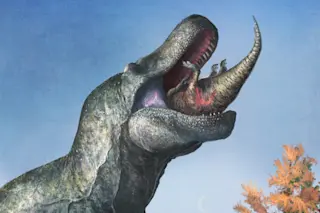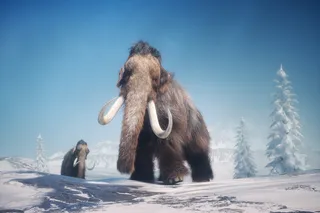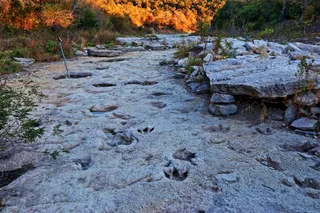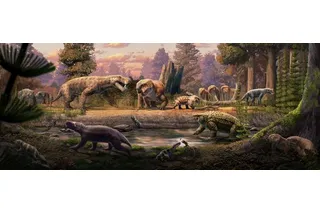The Tyrannosaurus is typically depicted with its fearsome fangs on full display. But a paper published in Science states that the theropod dinosaurs, such as Tyrannosaurus rex, actually had thin, lizard-like lips that hid their sharp, serrated teeth.

Tyrannosaurus rex bellowing with its mouth shut, like a vocalising alligator. With its mouth closed, all of the enormous teeth of T. rex would be invisible behind its lips. (Credit: Mark Witton)
Mark Witton
Theropod Teeth
The paleontologists and paleoartists who are tasked with depicting dinosaurs have long deliberated about the appearance of the theropods. While some have suggested that these predatory dinosaurs had lizard-like lips that covered and concealed their teeth, others have suggested that they lacked lips, exposing their teeth in a terrifying, snaggletoothed snarl.
“Dinosaur artists have gone back and forth on lips,” says study author Mark Witton, a paleontologist and paleoartist associated with the University of Portsmouth, according to a press release. “But lipless dinosaurs became more prominent in the 1980s and 1990s. They were then deeply rooted in popular culture through films and documentaries.”
That being said, the scientific basis behind these popular portrayals was thin.
“Curiously, there was never a dedicated study or discovery instigating this change,” Witton says in a release. “To a large extent, it probably reflected preference for a new, ferocious-looking aesthetic, rather than a shift in scientific thinking.”
Read More: Here’s What Dinosaurs Really Looked Like
Lipped or Lipless
Now, researchers have analyzed the teeth of the theropods more thoroughly, alongside the teeth of their more modern reptile relatives, finding that the ancient animals had scaly, soft tissues surrounding their teeth.
“We're upending this popular depiction by covering their teeth with lizard-like lips,” Witton says. “This means a lot of our favorite dinosaur depictions are incorrect, including the iconic Jurassic Park T. Rex.”
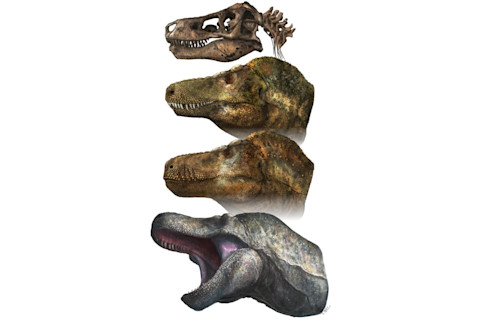
T. rex skull and head reconstructions (Credit: Mark Witton)
Mark Witton
All in all, the researchers say that their paper provides important insights into the diet and dental fitness of these dinosaurs. It also demonstrates the worth of a new approach for reconstructing the appearance of all sorts of ancient animals, including other dinosaurs.
“Some take the view that we’re clueless about the appearance of dinosaurs beyond basic features like the number of fingers and toes,” Witton says. “But our study, and others like it, show that we have an increasingly good handle on many aspects of dinosaur appearance.”
Read More: What a Tyrannosaurus Rex Skull Tells Us About Its Intelligence
Studying Dinosaur Smackers
To arrive at these findings, the researchers compared the tooth and mouth morphologies of the theropods with those of modern reptiles, with and without lips. Their comparisons revealed that the mouths of the theropods were much more similar to those of the lipped reptiles, like lizards, rather than the lipless reptiles, like crocodiles.
Of particular importance to their conclusions were tooth wear and size. While the wear seen in the theropods was very different from that seen in the lipless reptiles, the tooth size of the theropods was very similar to that of the lipped reptiles, relative to the size of their skulls.
“Although it’s been argued in the past that the teeth of predatory dinosaurs might be too big to be covered by lips, our study shows that, in actuality, their teeth were not atypically large,” says study author Thomas Cullen, a paleontologist associated with Auburn University, according to a press release. “Even the giant teeth of tyrannosaurs are proportionally similar in size to those of living predatory lizards when compared for skull size, rejecting the idea that their teeth were too big to cover with lips.”
According to the researchers, the theropod’s lips protected their teeth from excessive exposure to their environment, decreasing the amount of damage that their enamel sustained during feeding. And, since most modern lizards aren’t able to move their lips independently, the researchers also add that the theropods’ lips were not muscular, most resembling those of the monitor lizards.
“It’s quite remarkable how similar theropod teeth are to monitor lizards. From the smallest monitor to the Komodo dragon, the teeth function in much the same way,” says study author Derek Larson, a paleontologist associated with the Royal BC Museum in Canada, according to a press release, “even though they are not closely related.”
Ultimately, the researchers stress that their study applies to the theropods and the theropods, alone. So, while some dinosaurs undoubtedly displayed their teeth, the Tyrannosaurus was not one of them.
Read More: T. Rex Developed Different Shaped Eye Sockets For a Forceful Bite



